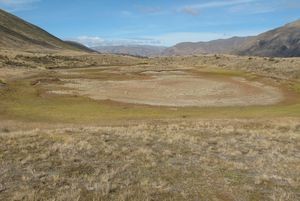 Kettle hole wetland in the Ahuriri Valley, Canterbury. Photographer: John Barkla.Ephemeral wetlands are depressional wetlands (i.e., dips or hollows) that temporarily hold water either after heavy rains or in early spring or early summer. These wetlands may periodically dry up, often in mid to late summer or following long periods of drought. Ephemeral wetlands are isolated without a permanent inlet or outlet, but at certain times may overflow. They are free of fish which allows for breeding of certain amphibians and invertebrates. Ephemeral wetlands support turf and swards on their margins and occasional rushlands and scrub vegetation further out from their core. Ephemeral wetlands occur in:
Kettle hole wetland in the Ahuriri Valley, Canterbury. Photographer: John Barkla.Ephemeral wetlands are depressional wetlands (i.e., dips or hollows) that temporarily hold water either after heavy rains or in early spring or early summer. These wetlands may periodically dry up, often in mid to late summer or following long periods of drought. Ephemeral wetlands are isolated without a permanent inlet or outlet, but at certain times may overflow. They are free of fish which allows for breeding of certain amphibians and invertebrates. Ephemeral wetlands support turf and swards on their margins and occasional rushlands and scrub vegetation further out from their core. Ephemeral wetlands occur in:
- hollows lined with volcanic tephra
- coastal sand dunes
- kettle-hole depressions on old glacial moraine
Ephemeral wetlands may also be referred to as ephemeral, seasonal or temporary ponds, vernal pools or temporal wetlands. The turfs of ephemeral wetlands support a large native flora with 419 native and 171 exotic plant taxa reported from wetland turfs (Johnson and Rogers 2003).
For more information see:
- Ephemeral wetlands and their turfs (Peter Johnson and Geoff Rogers - DOC 2003 )
- Factors causing dune ephemeral wetlands to be vulnerable to weed invasion (Paul Champion and Paula Reeves - DOC 2009)
- Types of wetland (Te Ara Encyclopedia)
